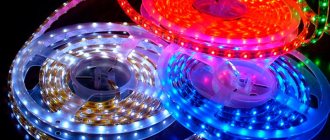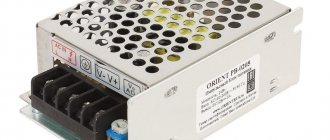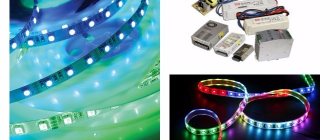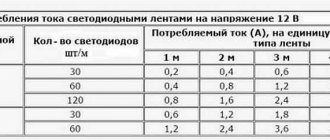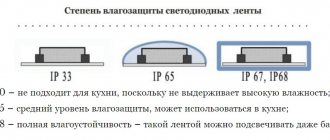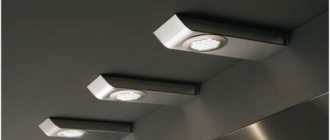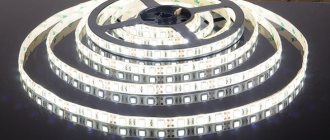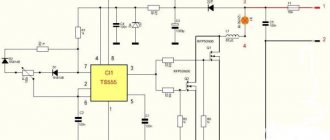What is a power supply for LED strip?
The power supply for the LED strip is a constant voltage source of 5, 12, 24 or 36 volts (48 volts are also available). It is used to convert alternating voltage from a 220 V network into a direct voltage of a certain level necessary for the operation of the LED strip. Sometimes power supplies for LED strips can be called LED drivers, but this is not entirely true. The term "LED driver" is most often used for power supplies to which LEDs are connected, which require a certain value of supply current. LED drivers implement a current stabilization mechanism that is limited to a certain value, but power supplies for LED strips do not have such a current limitation.
The LED strip is powered by a constant voltage, and the current flowing through the LEDs of the LED strip is limited using resistors installed in series with the SMD LEDs on the strip itself. The task of the power supply is to maintain the required voltage level, so it is not entirely appropriate to apply the term “driver for LED strip” to it.
Kinds
By device type, drivers are divided into linear and pulsed:
- Linear - based on a current generator with a p-channel transistor. They provide smooth current stabilization at unstable voltage. A simple configuration, low efficiency = 85%, low cost and high heat dissipation suggest the use of LEDs in low-power circuits. Plus - a smooth operating mode that does not create electromagnetic high-frequency interference.
- Pulse – generate high-frequency pulses at the output. The operating principle is PWM (pulse width modulation). The average output current is provided by the duty cycle (the ratio of the pulse duration to the number of repetitions). The change in the value of the average output current occurs due to a variation in the filling value from 10 to 80% at a constant pulse frequency. They are widely used due to their high efficiency (95%), long service life and small size. The disadvantages include a high level of interference.
Due to the presence of galvanic isolation, which provides increased efficiency, reliability and safety, preference should be given to drivers with this property. If there is no galvanic isolation, the driver is cheaper, but there is a danger of electric shock (no protection).
Calculation of power supply power for LED strip
The output voltage is the main characteristic of the power supply for an LED strip; if it is less, the LED strip simply will not emit light, and if it is more, something on it will burn out. Next they look at the power of the power supply, i.e. it should easily produce a certain current, which should be enough to operate all connected LED strips in their normal operating mode.
When designing LED lighting or decorative lighting using LED strips, the power of the power supply is calculated. The calculation is made to ensure that all connected LED strips shine with the required brightness, and the power supply for the LED strips is not overloaded during operation.
How is the power supply power for LED strips calculated? Everything is very simple, you just need to know the parameters of all LED strips connected to the power supply, i.e. you need to calculate the power consumption of all LED strips.
You might be interested in this Link to article: What determines the power of an LED strip
In the characteristics of the LED strip, the power is indicated per linear meter; if separate sections of LED strips with the same characteristics are connected to the power supply, then the indicated power per linear meter should be multiplied by the total length of the LED strips. Next, you need to add a margin of 20% to 30% to the result obtained, and round the resulting result to a larger integer multiple of ten.
It turns out that the calculated power of the power supply for LED strips will be greater than the actual consumption. This is done to ensure that the power supply does not operate beyond its capabilities, overheat and fail.
Main characteristics
The parameters are indicated on the ice driver body:
- Rated power - determines the load that can be connected to a given converter, depends on the power of each diode, color and quantity.
- The operating current is directly proportional to the power of the LEDs and the intensity of their radiation.
- Output voltage depends on the connection diagram of the LEDs and their number.
Rated power is calculated using the formula:
Pн=PLED*N,
where PLED is the power of one diode (commonly found 0.35 A and 0.7 A),
N is the number of diodes in the circuit.
The driver power (indicated on the housing) should be 20–30% greater than the calculated value. Pmax = 1.3*Pn. The load power depends on the color as follows:
- the red diode has a voltage drop of 1.9–2.4 V at 0.35 A. The power will average 0.75 W.
- the green diode has a voltage drop of 3.3–3.9 V at 0.35 A. The power will average 1.25 W.
A 10 W driver can power 13 red or 8 green LEDs.
There are almost all colors of LEDs: red, orange, yellow, green, blue, white. The voltage drop values can be found in the technical documentation for the diode.
What kind of block is needed for LED strip?
We have already discussed the main parameters of power supplies for LED strips above: supply voltage and power. It remains to consider other features and characteristics that are taken into account when choosing them.
In addition to voltage and power, power supplies for LED strips also differ in the type of design (case), degree of protection from external influences and functionality. Each of these options provides some advantages or limitations for use in different environments.
Three main types of power supplies for LED strips:
1. In a plastic case. 2. In a metal case with perforation. 3. Sealed in aluminum housing.
The power supply for LED strips in a plastic case can be similar to the power supply from a laptop or the power supply from various devices, for example, a battery charger for a powerful router and others. As a rule, low-power power supplies have a plastic case and can only be used indoors. They have passive cooling through the body, so they cannot withstand strong overloads.
The power supply for LED strip in a metal case with perforation usually has more than average power and corresponding dimensions. The radio components in them are cooled by air circulating in the case, and in powerful models a fan can be installed for forced airflow, which can be accompanied by a lot of noise. The advantage of such power supplies is the presence of a large number of pins, mainly for fairly powerful models, and a voltage level regulator, i.e. If necessary, they can be slightly adjusted. They are installed mainly in shields, where they will be protected from dust.
Sealed power supplies for LED strips in an aluminum case are well protected from dust and moisture. They are cooled passively through the case; for connection to the 220V network and to the LED strip there are wire sections. They can be installed both indoors and outdoors.
IP rating of LED power supplies
The protection class of a power supply affects the conditions in which it can be used. The most common power supplies for LED strips in a plastic case or in a metal case with perforation have a protection class of IP20 or IP40. This means that they can be used in dry rooms with a moderate amount of dust; it is better to hide perforated ones in switchboards, otherwise over time they will become completely clogged with dust.
Power supplies for LED strips in aluminum sealed cases have a protection class of at least IP65, and they can already be used in bathrooms and on the streets under a canopy. For outdoor use, more protection is required and the housing must be IP67 rated. There are even more protected power supplies with IP68 and even IP69. They can already withstand direct exposure to jets of water and even complete immersion in water up to 1 m.
Types of power supplies for LED strips by functionality
1. The most common ones, performing only the function of powering the LED strip. 2. Power supplies with a built-in dimmer for brightness adjustment. 3. Power supplies for LED strips with remote control. 4. The most expensive combined power supplies with a control panel and a dimmer.
The functionality of the power supply allows you to save space and increase ease of use, so as not to have many different devices in one place. In the most expensive option, instead of three devices, you can install only one power supply for the LED strip, in which everything is already included. At the same time, the simplest power supplies without bells and whistles can boast of their small size.
Choice
We have already discussed how to choose the power of a transformer. However, in some cases it is more advisable to use several low-power transformers instead of one powerful device. This can be done, for example, based on considerations of the location of individual sections of the LED strip. Or, based on the dimensions, when the question arises of where to hide a high-power transformer.
We have already dwelled on the advantages of “electronic” transformers. However, the electronic components used in them are more demanding for effective cooling. Often, to cool the electronics of such power supplies, fans are installed inside the case.
The choice of power supplies should be approached with some caution, since over time the fans sometimes begin to make quite loud noise and measures have to be taken to eliminate the noise. It is better to opt for converters in which the housing serves as a radiator for heat removal. Such cases have a developed ribbed surface.
When choosing a transformer, you need to consider the location of its installation. If the lighting is intended to be installed outdoors or in damp rooms, it is necessary to select a device with the appropriate protection class.
Additionally, you can watch an interesting video about choosing a transformer. The author gives useful comments that will definitely come in handy when choosing a transformer.
DIY power supply for LED strip
Let’s immediately clarify one point: it’s not profitable to independently develop, solder and assemble power supplies according to various circuits for LED strips in our time, and we won’t even consider this option.
Nowadays, there are many different devices that are equipped with external power supplies of 12 V or more, and each home has several that can easily serve as a power supply for an LED strip, provided the power is suitable.
If you don’t have such a power supply from old devices, then your neighbor probably has one, or you can buy one very cheaply at a flea market, or on ad sites. As a powerful power supply, you can consider a computer power supply. Old system units have power supplies with a power of 250 W to 400 W; modern computers do not use these and sell them for pennies. And they, by the way, have outputs with voltages of 5 V, 12 V and 24 V, so you can record any type of LED strips.
There are power supplies from laptops; the voltage in them can be 18 V or more. To connect an LED strip to them, you will need to use a DC-DC step-down voltage converter. In China, on AliExpress, such converters cost pennies, the main thing is to choose the right power.
There is a category of DC-DC converters that have both voltage and current regulation. In this case, they can act as a voltage source and a dimmer to adjust the brightness of the LED strip.
It is better not to use linear voltage regulator circuits, because they will have large losses and will require a bulky radiator to cool powerful transistors. Pulse converters greatly benefit in this regard.
Features of transformer installation
Installation of transformers is carried out according to the diagram, which should be attached to the LED strips themselves. Usually they are cut into pieces with three diodes in each group. The design assumes the presence of a current-limiting resistor. But in some cases there may be from 5 to 10 diodes on one part.
The location of the cut is indicated by groups of contacts on both sides. LEDs are connected in groups in parallel. The transformer can be installed anywhere in the room, but the polarity “+” or “ –».
When buying a transformer, you need to make sure that it is actually designed for LEDs, as some people mistakenly choose devices that are used for halogen lamps. Although they can lower the voltage to the required 12 volts, they produce alternating current at the output, since LED strips require direct current to operate.
- The power supply must be equipped with a soft start system, which will help to significantly increase the life of the tape.
- The device must have about 20–30% power reserve.
- It is recommended to install it in a place where it can be easily reached.
- If you install the unit in a small room, it will overheat greatly, which will lead to breakdown.
- It is important to consider the degree of protection of the block.
Connecting the LED strip to the power supply
When connecting an LED strip to a power supply, you need to follow some rules for connecting individual sections of LED strips. For example, it is better to connect in parallel, no more than five meters can be connected in series, it is best to connect the beginning and end of the tape to the power supply, etc., but we will not consider these subtleties now. Next, we will examine the connection issue in terms of selecting the wire with which the tape is connected directly to the power supply.
The importance of correctly selecting the wire for connecting the LED strip is that a large voltage drop can occur on an incorrectly selected wire, which will ultimately affect the brightness of the LED strip. What kind of wire is needed to connect the LED strip can be calculated if you know some initial data.
To calculate, you will need to know the power consumed by all LED strips, the supply voltage of the LED strips and the length of the wire, i.e. at what distance will the LED strips be from the power supply? It is also known that for normal operation of the LED strip, the voltage drop on the wires is allowed within 0.5 V.
For example, take the following data: Supply voltage – 12 V Wire length – 10 m Power consumption – 120 W
From the available data, we first need to calculate the maximum resistance of the wire using the following formula R=U/I. We have a voltage equal to 0.5 V, but we calculate the current using this formula I=W/U. In this formula we take the power of the LED strips and the voltage from the supply, it turns out I = 10 A. Now you can simply calculate the resistance, which will be equal to 0.05 Ohm, i.e. the total resistance of the entire length of the wire should not exceed this value.
Now we will calculate the cross-section of the cable core that we will need to connect the LED strip to the power supply, and for this we will need the resistivity of copper, since our wire will be copper. The resistivity of copper is ρ=0.0172 Ohm* mm²/m. We will make the calculation using the following formula S=(L* ρ)/R. The result was 3.44 mm². The nearest larger cable cross-section that is commercially available will be 4 mm². By purchasing such a cable to connect the LED strip to the power supply, you can be sure that the LED strip will shine at its full brightness.
Connecting an LED strip without a power supply
The only LED strip that can actually be connected without a step-down power supply is a 220 V LED strip. Using such an LED strip for decorative lighting of some objects in the room is extremely inconvenient due to the features of this type of LED strip.
In theory, connect a sufficient number of LED strips in series to connect them to a 220 V network without a power supply, but no one does this, because ordinary strips have exposed contacts and this can lead to dire consequences.
Sometimes they still use simple connection schemes through ballast limiting capacitors, but the LED strip should be inaccessible for human touch. This method is quite simple, and this option cannot be called a power supply, but it has its drawbacks. With this connection, the LED strip is connected to a 220 V network, which is very dangerous; in addition, there will be large voltage ripples, accompanied by flickering of the emitted light.
